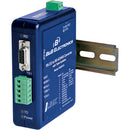Description
Engineered for rugged industrial environments, the B&B INDUSTRIAL RS232 TO RS485 DB9 DINRAIL converter is designed to bridge legacy serial interfaces with modern RS-485 networks and RS-422 compatible setups. This device is purpose-built for automation, control panels, and machine-to-machine networking, delivering reliable serial communication where reliability and uptime matter most. The RS-232 side offers a standard DB9 interface for host devices, while the field side supports RS-422/RS-485 signaling to enable robust multi-drop networks over longer distances and through electrically noisy environments. The unit is compact, DIN rail mountable, and features terminal blocks for straightforward power and data input, simplifying installation and reducing wiring complexity in crowded control cabinets. Built to withstand the rigors of factory floors, it is hardened for temperature extremes and designed with EMC considerations to minimize interference with adjacent equipment. Many models include galvanic isolation to protect critical controllers from ground loops and voltage transients, preserving data integrity and extending the life of connected devices. Regardless of the task—from retrofitting older machinery to integrating distributed sensors and actuators—the converter provides a dependable bridge between serial devices and modern field networks, enabling seamless automation and control across your system.
- DIN rail mountable design for fast, secure installation in control panels and industrial enclosures.
- RS-232 to RS-422/RS-485 translation enables reliable serial networking across long distances and through electrical noise.
- DB9 connector on the host side paired with terminal blocks for power and data input, delivering a clean, integrated wiring solution.
- Rugged construction with isolation (model dependent) and engineering for temperature extremes, ensuring performance in harsh environments and in EMC-conscious applications.
- Ideal for automation projects, OEM retrofits, and control-panel wiring where legacy serial devices must communicate with modern distributed networks.
Technical Details of B&B INDUSTRIAL RS232 TO RS485 DB9 DINRAIL
Note: Specifications vary by model and SKU. The following highlights reflect common characteristics of B&B industrial serial converters used in automation and control-panel deployments. For exact specs, refer to the SKU-specific datasheet or the distributor’s specification page.
- Serial interfaces: RS-232 on the host side (DB9) and RS-422/RS-485 on the field side for multi-point networks and robust data transmission.
- Mounting: DIN rail compatible enclosure designed for standard industrial panels and electrical cabinets.
- Power and data input: Terminal blocks for power supply and data connections, enabling a compact, organized wiring approach.
- Isolation: Galvanic isolation options are available on select models to protect controllers and reduce ground-loop issues (model dependent).
- Environmental durability: Hardened construction suitable for operation in environments with temperature fluctuations and demanding ambient conditions.
- EMC readiness: Engineered to minimize electromagnetic interference and to meet common industrial EMC requirements.
How to Install B&B INDUSTRIAL RS232 TO RS485 DB9 DINRAIL
Installing this RS232 to RS485 converter in a DIN rail system is straightforward for technicians familiar with serial equipment and industrial panel wiring. Follow these general steps to ensure a secure, reliable setup that preserves signal integrity and reduces commissioning time:
- Power down the control panel and verify that the DIN rail section is clean, properly grounded, and free of obstructions that could impede cabling and ventilation.
- Mount the converter on a suitable section of the DIN rail inside the enclosure, ensuring it sits firmly and has clear access to cables for routing and future maintenance.
- Connect the host device to the DB9 RS-232 side using a standard RS-232 cable. Verify pinout and handshake requirements as dictated by the host equipment to ensure proper initialization and data transfer.
- Wire the field network to the RS-422/RS-485 terminals via the terminal blocks. Observe correct polarity and, if necessary, arrange line termination and biasing per the network topology and number of devices on the bus.
- Attach the power supply to the power terminal block and provide the appropriate voltage per the model’s specifications. Ensure polarity is correct and that the supply is within the recommended range to prevent damage.
- Secure all connections, perform a basic communication test (loopback or diagnostic if available), and power up the system to confirm proper operation, data transmission, and error-free communication across the RS-485/RS-422 network.
Frequently asked questions
- Q: What interfaces does this converter provide? A: It offers RS-232 on the host side via a DB9 connector and RS-422/RS-485 on the field side, enabling reliable serial networking in automation environments.
- Q: Does it include galvanic isolation? A: Isolation is model-dependent. Some variants offer galvanic isolation to protect equipment and reduce ground-loop issues; please verify the SKU for isolation features.
- Q: Is DIN rail mounting supported? A: Yes. The unit is designed for DIN rail installation, which is common in control panels and industrial cabinets for neat, secure mounting.
- Q: Can it operate in temperature-extreme environments? A: The design is hardened for harsh industrial conditions and engineered to withstand temperature fluctuations encountered in factory floors and outdoor enclosures.
- Q: How should I power the device? A: Power is supplied through the terminal blocks. The required input voltage and range depend on the specific model, so consult the SKU datasheet for exact power specifications.
- Q: Does it provide EMC compliance? A: The converter is built with EMC considerations to minimize interference with nearby equipment and meet common industrial standards.
Customer reviews
Showing - Of Reviews


